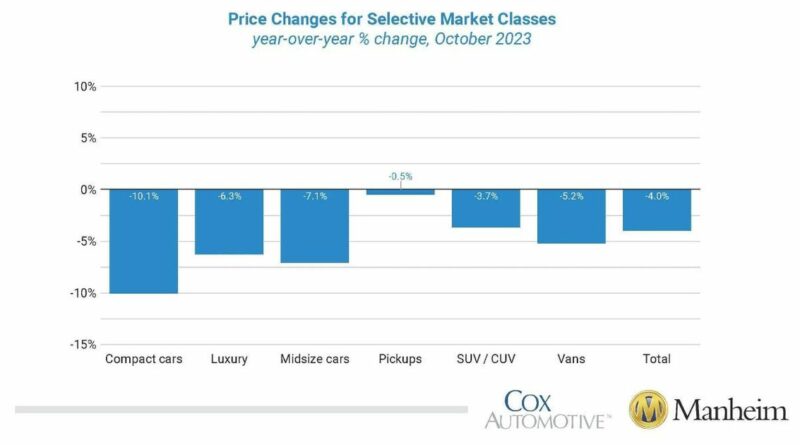Wholesale Used Vehicle Prices Reverse Two Months of Gains
All major market segments saw seasonally adjusted prices that were lower year over year in October.
Graphic: Cox Automotive
Wholesale used-vehicle prices (on a mix, mileage, and seasonally adjusted basis) decreased 2.3% in October from September, according to the Manheim Used Vehicle Value Index (MUVVI) released Nov. 7, which dropped to 209.4 and was down 4% from a year ago.
“October revealed some not-so-spooky price moves, namely a reversal of the gains that were seen during the prior two months,” said Chris Frey, senior manager of economic and industry insights for Cox Automotive. “This confirms the caution that was mentioned last month about not getting ahead of ourselves. The UAW strike appears to be settled, avoiding one action that could have led to higher wholesale prices. October’s price decline is eerily similar to last October’s 2.2% drop, and this was not unexpected as the market remains balanced. Wholesale vehicle values typically experience some modest increases during the holiday season, and with two months remaining, we could see some upward price movements.”
Recent News: U.S. Auto Sales Rise Last Month Despite UAW Strike
The seasonal adjustment reduced the October decrease. The non-adjusted price in October declined by 3.1% compared to September, moving the unadjusted average price down 6.3% year over year.
In October, Manheim Market Report (MMR) values saw above-average weekly declines that peaked in intensity in the middle of the month. Over the last four weeks, the Three-Year-Old Index declined an aggregate of 3.6%. Those same four weeks delivered an average decline of 2.4% in 2014-2019. During October, daily MMR Retention, which is the average difference in price relative to the current MMR, averaged 98.6%, meaning market prices were below MMR values. The average daily sales conversion rate dropped to 52.9%, which indicates that demand has declined but remains at a decent level for this time of year. For comparison, the daily sales conversion rate averaged 52.2% in October 2019. The sales conversion rate in October was the lowest in three months but stronger than in June and July.
The major market segments saw seasonally adjusted prices that were lower year over year in October. Compared to October 2022, pickups and SUVs lost less than the industry, down 0.5% and 3.7%, respectively. Compact cars continued as the worst performers year over year, down 10.1%, followed by midsize cars, down 7.1%; luxury, down 6.3%; and vans, off by 5.2%. Compared to last month, luxury and pickups lost less than the industry at 1.7% and 2%, respectively. Both vans and midsize cars declined by 3%, SUVs were down 2.7%, and compact cars lost 2.3%, flat versus the industry.
Used Retail Vehicle Sales Decreased in October
Assessing retail vehicle sales based on observed changes in advertised units tracked by vAuto, Cox initially estimates that used-vehicle retail sales in October were down 2% compared to September, and the year-over-year comparison with 2022 worsened again. Used retail sales are estimated to be down 4% year over year in October. The average retail listing price for a used vehicle declined 0.7% over the last four weeks.
Using estimates of used retail days’ supply based on vAuto data, an initial assessment indicates October ended at 49 days’ supply, down one day from 50 days at the end of September and five days lower than how October 2022 ended at 54 days. Leveraging Manheim sales and inventory data, wholesale supply is estimated to have finished October at 27 days’ supply, up one day from the end of September and down one day from October 2022’s estimate of 28 days.
October’s total new-light-vehicle sales were up 1.5% year over year, with one less selling day versus October 2022. By volume, October new-vehicle sales were down 9.6% month over month. The October sales pace, or seasonally adjusted annual rate (SAAR), came in at 15.5 million, an increase of 5.6% from last year’s 14.7 million and down 1.2% from September’s 15.7 million pace.
Combined sales into large rental, commercial, and government fleets decreased 10.4% year over year in October. Sales into rental fleets were down 7.1% year over year, sales into commercial fleets were down 21%, and sales into government fleets were up 31%. Including an estimate for fleet deliveries into dealer and manufacturer channels, the remaining retail sales were estimated to be up 3.3%, leading to an estimated retail SAAR of 13.4 million, up 0.9 million from last year’s 12.5 million pace, and up 0.5 million from last month’s 12.9 million pace. Fleet market share was estimated to be 13.5%, down from last year’s 15% share and down 0.3% from September’s 13.8% share.
Rental Risk Prices and Mileage Both Down in October
The average price for rental risk units sold at auction in October declined 2.1% year over year. Rental risk prices also decreased by 4.4% compared to September. Average mileage for rental risk units in October (at 50,500 miles) was down 10.5% compared to a year ago and down 1.4% from September.
Measures of Consumer Confidence Declined Again in October
- The Conference Board Consumer Confidence Index declined by 1.6% in October, as both future expectations and views of the present situation declined. Consumer confidence was up 0.4% year over year as three months of declines wiped out the gains from the spring and early summer. Plans to purchase a vehicle in the next six months declined to the lowest level since April and were down year over year.
- The confidence index did not fall as much during the pandemic as the sentiment index from the University of Michigan. Both series declined over the last three months after improving in June and July. The Michigan index declined 6% for the month but was up 1.3% from the mid-month reading. The final index number for the month was up 6.5% year over year. Consumer expectations for inflation increased, with median expectations for inflation over the next year at the highest level since May. The consumer’s view of buying conditions for vehicles improved slightly as views of prices were less negative, but views of interest rates deteriorated.
- The daily index of consumer sentiment from Morning Consult measured only a small decline in October, as the index declined 0.1% from the end of September.
- Gas prices fell substantially in October, erasing all of the gains from the spring and summer. The national average price for unleaded gas declined 9.3% in October to $3.46 per gallon, which was down 8% year over year, according to AAA.
Source: Read Full Article




